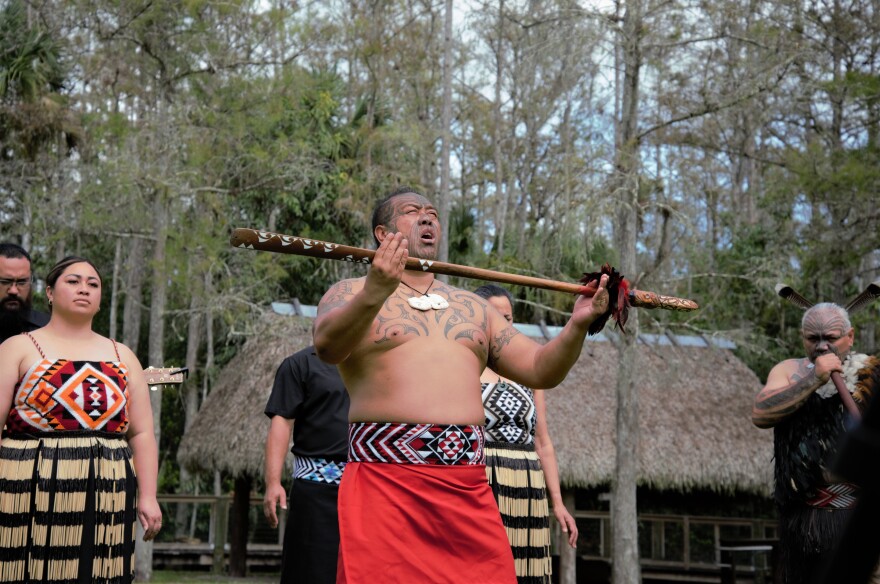Gordon Wareham is playing a Native American flute, an instrument he’s been perfecting for the last 22 years.
“You give the instrument its breath, and in turn, it gives you a voice,” said Wareham.
Wareham is a Seminole member of the Panther Clan and lives on the Hollywood Florida Reservation. He’s director of the Seminole Tribe of Florida’s Ah-Tah-Thi-Ki Museum here at the Big Cypress Seminole Indian Reservation.

The museum’s American Indian Arts Celebration (AIAC) started 20 years ago as a small festival aimed to educate local schools about Seminole culture during Native American Heritage Month. But now, he says, the festival has grown exponentially.
“We're bringing in indigenous people from around the world to come and celebrate this special month with us and educate not just our tribal members, but also local, surrounding communities,” said Wareham.
Six members of New Zealand’s HAKA Māori Cultural Experience are performing a welcome song and dance on the reservation’s ceremonial grounds. The Māori are the indigenous people of New Zealand.

To see HAKA performed is a visceral experience. The Māori rhythmically move together in unison, stomping their feet and slapping their bodies as they alternately sing and chant. Their expressions are exaggerated with widened eyes and at times sticking out their tongues sharply.
During the celebration, 20 members of the HAKA Māori Cultural Experience will perform for the public. Craig Muntz, the group's director, says HAKA is misunderstood in popular culture.
“A common misconception of HAKA is that it's just a war dance. HAKA is a generic term for dance, and you dance for many different reasons.”
Muntz says the main thing about HAKA and Māori performing arts is the message of the songs. He says songs can be written about topical issues like environmental rights, social justice, and domestic violence. But HAKA is also about joy.
“HAKA is also composed to celebrate and to acknowledge and pay tribute.”
Dispelling myths about indigenous culture and explaining who the Seminole people are today is a great focus for the Ah-Tah-Thi-Ki Museum.
The Seminoles of Florida are known as the "Unconquered People" as descendants of a few hundred Native Americans who managed to evade capture by the U.S. Army in the 19th century.

Right now, more than 2,000 live on six Florida reservations, and close to 700 Seminoles live on the Big Cypress Reservation in the heart of the Everglades.
Wareham says the history about indigenous life is sometimes lost in textbooks, but they’re actively working on correcting the narrative.
“Our story usually ends in 1850," said Wareham. "Right after the third Seminole Wars, we’re not mentioned anywhere. But in Florida, I always have a saying that, ‘we're not part of Florida's history. We are Florida.’ We've always been here. And we will always be here.”
The American Indian Arts Celebration will feature traditional Seminole cuisine, music and fashion, and the Ah-Tah-Thi-Ki Museum is displaying a new artifact for the first time: a sash worn by Seminole leader Osceola.

“You come from someplace and someplace special," said Wareham. "That's your lineage. That’s your heritage, and come and learn about yourself and come about learn about the unique culture.”
WGCU is your trusted source for news and information in Southwest Florida. We are a nonprofit public service, and your support is more critical than ever. Keep public media strong and donate now.








